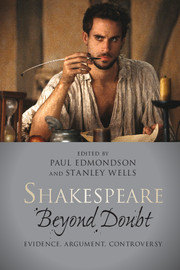General introduction
Published online by Cambridge University Press: 05 April 2013
Summary
In August 1856, a 45-year-old American lady by the name of Delia Bacon paid a visit to Stratford-upon-Avon, where she lodged initially at 15 College Street, not far from Holy Trinity Church. She met with the vicar, George Granville, who allowed her access outside normal visiting hours to Shakespeare’s grave, which she wished to investigate in the hope that it concealed solutions to an imagined code which would demonstrate that there were reasons to question received ideas about the authorship of Shakespeare’s works. ‘“If I only had the proper tools”, she complained to herself, “I could lift the stone myself, weak as I am, with no one to help” … A strange weariness overcame her. She left, her mission unaccomplished.’
We can relate these events around Shakespeare’s grave to numerous aspects of the intellectual and cultural climate of the time which occupied the popular imagination: Gothic fiction and drama with their tales of subterranean passages and arcane messages; the questioning of religious orthodoxy; geological discoveries; the authorship of the Homeric poems; archaeological investigations; and the search for the origins of life. Charles Darwin’s The Origin of Species was to be published three years later, in 1859. Detective fiction with its emphases on the solving of mysteries and the imposing of an all-controlling pattern on a world uncertain of itself was beginning to appear. One of its earliest exponents was Edgar Allan Poe, whom Bacon herself had beaten to the prize in a short story competition.
- Type
- Chapter
- Information
- Shakespeare beyond DoubtEvidence, Argument, Controversy, pp. xi - xivPublisher: Cambridge University PressPrint publication year: 2013



